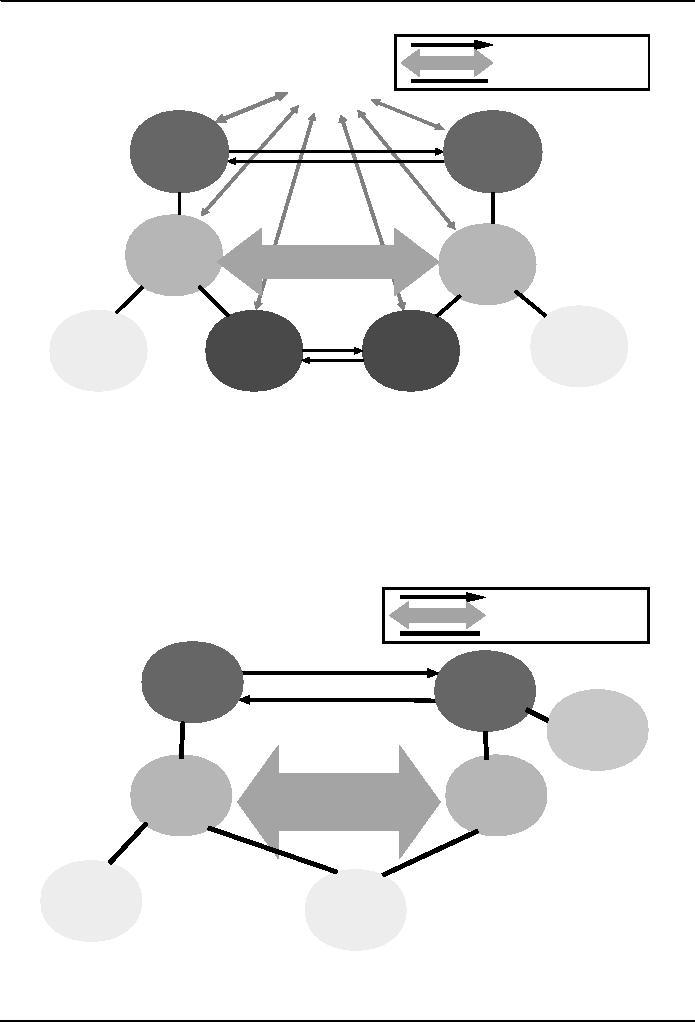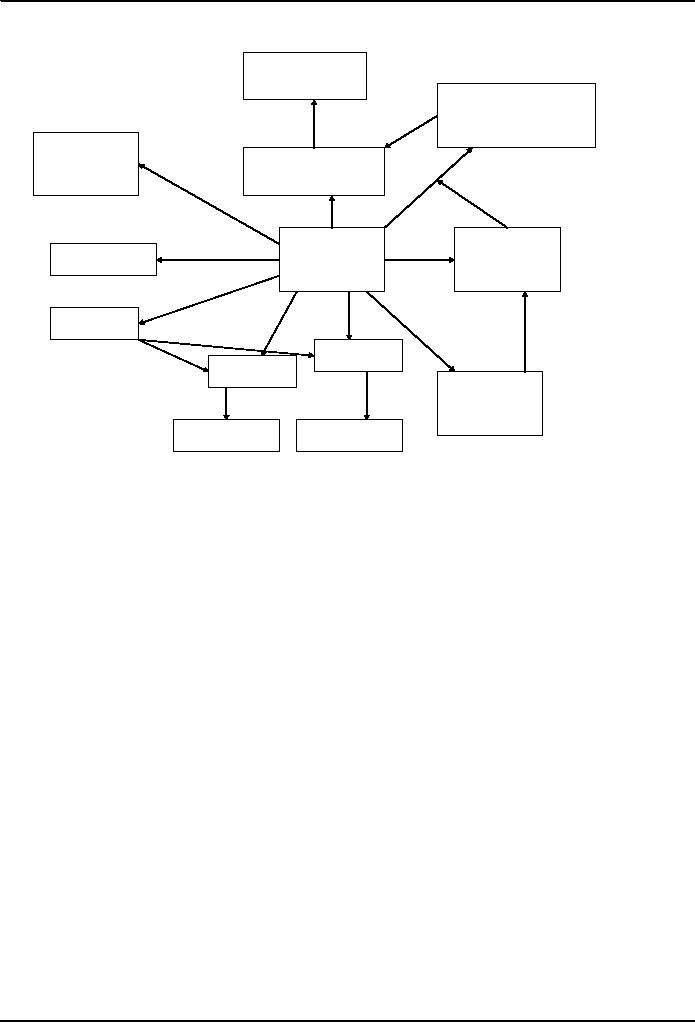 |

Conflict
Management HRM624
VU
Lesson
9
DESCRIBING
THE CONFLICT I
Quotation
"There
are three principles in a man's being
and life, the principle of
thought, the principle of speech,
and
the
principle of action. The origin of
all conflict between me and
my fellow-men is that I do not
say what I
mean
and I don't do what I say".
(Martin
Buber)
Description of
Conflict
Make
sure that we understand the
roles of the parties to a conflict.
Clarify that often there
are several
interpersonal
conflicts hidden in a situation, and that
the participant role assignments
may change if the
focus
of the dispute is changed.
Tease
out underlying and hidden
interpersonal conflicts. It will help uncover
paths to constructive
resolution
of the conflict.
Identifying
Interpersonal Conflict
� Analyze the
situation carefully to ensure it really
is "interpersonal" and not an
"inner conflict."
� Identify
the disputants, and the divergent goals
and interests that create
the interpersonal conflict.
� Now,
start diagramming or mapping the
conflict.
Purposes
of the conflict map or
"sociogram"
When
it is decided that a conflict is
interpersonal conflict not intrapersonal
conflict, then we map out
the
conflict.
Following
are the purposes of a map or
sociogram:
1. It
clarifies what the conflicts are among
the disputants.
2. It
helps us analyze disputants'
interests.
3. It
reveals interests of non-disputants that
may impede resolution or
provide ways to
creative
strategies
to resolve the conflict.
4. It
clarifies the points on which more
information is needed.
Place
symbols on the sociogram that
represent the disputants and
briefly write the divergent goals of
the
principal
disputant.
Evaluate the
situation, conduct research where
necessary, to identify agents,
advocates, and
constituents.
Place
them on the sociogram as well.
Explain
the sociogram with side conflicts
that add to the complexity of the
situation.
Be
prepared to edit the sociogram as
and when additional
information becomes
available.
Keep
in Mind the
complexity
Many
conflict situations will
have more than one
interpersonal conflict.
i. Who
are the main disputants,
agents, advocates, constituents, or
neutrals, if any? This explanation
will
depend
on the conflict that is being
focused.
ii.
Often, we know which
conflict to focus on. Some
times, we have to decide
systematically which
conflict
is to be
focused. Usually there are
multiple conflicts.
B. Whether to
include some individuals with
loose connections to the conflict as
constituents will
depend
on our
goals. It will be good to include
all conflicts.
33

Conflict
Management HRM624
VU
Parties to
an
Lines of
communication
Conflict
under consideration
Interpersonal
Conflict
Neutral
Lines of
relationship
Advo-
Advo-
cate
cate
Disput-
THE
CONFLICT:
Disput-
ant
Incompatible
Goals
ant
Consti-
Consti-
Agent
Agent
tuent
tuent
Sample
Interpersonal Conflict
Saleem
and Naila are in the process
of divorcing; and disagree
over the custody of their
two children
� Lawyer
Babar represents Saleem and
Salma represents
Naila
� The
children are upset with
each other. They blame each
other for the impeding divorce
between
their
parents.
� Babar's
mother can not decide about
her possible role to resolve
their dispute by providing
child
care,
if given custody of children to the
father.
Lines of
communication
Conflict
Map
Conflict
Lines of
relationship
Babar
ADVOCATE
ADVOCATE
Salma
Ayesha
(secre-
tary)
CONSTITUENT
Saleem
Naila
DISPUTANT
The conflict:
Children
DISPUTANT
custody
dispute
Mother
The
kids
CONSTITUENT
CONSTITUENTS
Important
Point
Roles
of participants change, depending on which
interpersonal conflict is given
focus.
34

Conflict
Management HRM624
VU
Manager
Factory +
Fellow Workers
Dear
Friend
Supervisor
Sick
Father
Mother
Factory
worker
Wife
Kid
2
Kid
1
Brother
School
School
35
Table of Contents:
- INTRODUCTION TO CONFLICT:Dispute, Legal Dispute, Call the police
- DISPUTE RESOLUTION 1:Positive affect in Negotiation, Alternative Dispute Resolution
- DISPUTE RESOLUTION II:Adjudication, Litigation, Mediation-Arbitration
- PRECONCEPTIONS ABOUT CONFLICT I:Pedagogical development, Pressures against Innovation
- PRECONCEPTIONS ABOUT CONFLICT II:Cultural beliefs about interpersonal conflict, Why strategies of change fail
- CONFLICT DIAGNOSIS:Who Needs to Know About Conflict Diagnosis?, Steps in Conflict Diagnosis
- RECURRENT THEMES IN CONFLICT DIAGNOSIS I:The Seven Steps of Social Behavior, Seven steps to diagnose conflict
- RECURRENT THEMES IN CONFLICT DIAGNOSIS II:Themes of Conflict Diagnosis
- DESCRIBING THE CONFLICT I:Description of Conflict, Identifying Interpersonal Conflict
- DESCRIBING THE CONFLICT II:Step 1 for Conflict Diagnosis, interpersonal or intrapersonal
- SOURCES AND CAUSES OF CONFLICT I:Main Sources of Conflict, Discussing major sources of conflict
- SOURCES AND CAUSES OF CONFLICT II
- INTEREST ANALYSIS I:Analyzing your interests, Analyzing the other disputant’s interests
- INTEREST ANALYSIS II:What are interests?, Tips for Interest Trees
- INTEREST ANALYSIS II:Principles and values, Basic Human Needs
- ASSESSING THE CHARACTER OF THE CONFLICT I, Premises of Deutsch’s Theory
- ASSESSING THE CHARACTER OF THE CONFLICT II:Techniques to transform competitive conflict into cooperative
- TRUST AND ITS SIGNIFICANCE I:What is Mistrust,Trust and business,Three levels of trust
- TRUST AND ITS SIGNIFICANCE II:Advantages of high trust level, Building of trust
- ASSESSING IMPEDIMENTS TO RESOLVE THE CONFLICT I:Motivation to seek vengeance, Mistrust
- ASSESSING THE IMPEDIMENTS TO RESOLVING THE CONFLICT II:Disempowered Disputant, Unpleasant Disputant
- ASSESSING THE NEGOTIATING STYLE I:Dual Concern Model, Dominating or competition style
- ASSESSING THE NEGOTIATING STYLE:Dual Concern Model, Tactics Used In Integrating
- ASSESSING POWER AMONG DISPUTANTS:Conflict and Power, Kinds of power in the Relationship Domain
- ASSESSING POWER AMONG DISPUTANTS II:Sources of Relationship Power, Context and Power
- POWER, CONFLICT, AND BATNA III:Role of Third Party in BATNA, Dealing with Power Imbalance
- STEREOTYPES, DIVERSITY, AND CONFLICT I:Stereotyping, Stereotyping in Interpersonal Conflict
- STEREOTYPES, DIVERSITY, AND CONFLICT:Categories of Diversity Issues, Seven Mental Processes to Prove Stereotypes
- STEREOTYPES, DIVERSITY AND CONFLICT III:Individual Difference and Social Category, Cultural differences in values
- MEDIATION I:When is mediation required, Processes Related to Mediation, Product of Mediation
- MEDIATION II:Important distinguishing factors, More Advantages and Disadvantages of Pure Mediation
- ADVANTAGES AND DISADVANTAGES OF MEDIATION I:Efficiency Consideration, Conflict Management and Prevention
- ADVANTAGES AND DISADVANTAGES OF MEDIATION II:Quality of Consent, Effects on the parties to mediation
- PROCESS OF MEDIATION:Stages of Mediation, Facilitative tactics in mediation
- LAW AND ETHICS OF MEDIATION I:Characteristics of mediation, Confidentiality
- LAW AND ETHICS OF MEDIATION II:Role of ethics in mediation, 8 Dimensions of Ethics in Mediation
- ARBITRATION I:Ways to Resolve Conflict, Advantages of Arbitration, Disadvantages of Arbitration
- ARBITRATION II:Varieties of Arbitration, Process of Arbitration, Contents of Arbitration Act
- NON BINDING EVALUATION:Disadvantage, Varieties of Non-binding Evaluation
- NON BINDING EVALUATION II:Varieties of Non-binding Evaluation, Advantages and disadvantages of Non-binding Evaluation
- MIXED AND MULTIMODAL DISPUTE RESOLUTION:Six System Design Principles, Extensions of Dispute Systems Design
- POWER TOOLS AND MAGIC KEYS I:Introduction, Necessity of conflict diagnosis, Using conflict diagnosis
- POWER TOOLS AND MAGIC KEYS II:Proposed Contents of a Clients’ Interview, Impediments to use facilitative mediation
- PANCHAYAT, LOCAL GOVERNMENT SYSTEM, AND ADR, Definitions of Panchayat, Definition of Jirga
- SUMMARY AND MESSAGE OF THE COURSE:Definitions of conflict, Negotiation, Meditation, Adjudication